Process
Most garments are shipped by sea freight from the country of production. They get very wrinkled because of the box packing being used. In the receiving country, they are unpacked and put on a clothes hanger. Those hangers are sent via automated transport through the tunnel with a speed up to 3,000 garments per hour. These garments are then sent to a room to be steamed and dried. [3]

A country is a region that is identified as a distinct entity in political geography. A country may be an independent sovereign state or part of a larger state, as a non-sovereign or formerly sovereign political division, or a geographic region associated with sets of previously independent or differently associated people with distinct political characteristics. Regardless of the physical geography, in the modern internationally accepted legal definition as defined by the League of Nations in 1937 and reaffirmed by the United Nations in 1945, a resident of a country is subject to the independent exercise of legal jurisdiction. There is no hard and fast definition of what regions are countries and which are not.
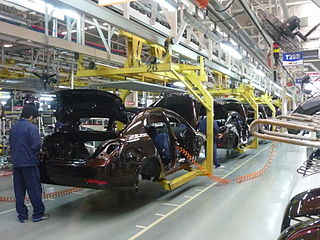
Manufacturing is the production of products for use or sale using labour and machines, tools, chemical and biological processing, or formulation. The term may refer to a range of human activity, from handicraft to high tech, but is most commonly applied to industrial design, in which raw materials are transformed into finished goods on a large scale. Such finished goods may be sold to other manufacturers for the production of other, more complex products, such as aircraft, household appliances, furniture, sports equipment or automobiles, or sold to wholesalers, who in turn sell them to retailers, who then sell them to end users and consumers.
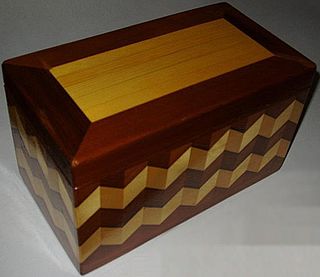
Box describes a variety of containers and receptacles for permanent use as storage, or for temporary use, often for transporting contents.
The machine processes each garment through several stages. First, the garment passes through a steam chamber to make the fabric moldable. Then wrinkles are removed by a strong hot air flow alongside the garments. Finally, the garment is dried by cooler air before it leaves the tunnel finisher. In the case of garments, smaller areas such as collars require further pressing using other equipment such as steam iron for a better finish. [4]

A clothes iron is a device that, when heated, is used to press clothes to remove creases. It is named for the metal of which the device was historically commonly made, and the use of it is generally called ironing. Ironing works by loosening the ties between the long chains of molecules that exist in polymer fiber materials. With the heat and the weight of the ironing plate, the fibers are stretched and the fabric maintains its new shape when cool. Some materials, such as cotton, require the use of water to loosen the intermolecular bonds.
The tunnel finisher is also used in laundries and dry cleaners to remove wrinkles from garments after washing or dry cleaning.
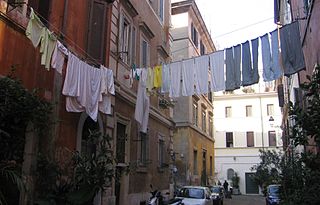
Laundry refers to the washing of clothing and other textiles. Laundry processes are often done in a room reserved for that purpose; in an individual home this is referred to as a laundry room or utility room. An apartment building or student hall of residence may have a shared laundry facility such as a tvättstuga. A stand-alone business is referred to as a self-service laundry. The material that is being washed, or has been laundered, is also generally referred to as laundry.
Dry cleaning is any cleaning process for clothing and textiles using a chemical solvent other than water. The modern dry cleaning process was developed and patented by Thomas L. Jennings.

Linen is a textile made from the fibers of the flax plant. Linen is laborious to manufacture, but the fiber is very strong, absorbent and dries faster than cotton. Garments made of linen are valued for their exceptional coolness and freshness in hot and humid weather.

A clothes hanger, coat hanger, or coathanger, is a device in the shape of:

A mangle or wringer is a mechanical laundry aid consisting of two rollers in a sturdy frame, connected by cogs and, in its home version, powered by a hand crank or electricity. While the appliance was originally used to wring water from wet laundry, today mangles are used to press or flatten sheets, tablecloths, kitchen towels, or clothing and other laundry.

Wet cleaning refers to methods of professional cleaning that, in contrast to traditional dry cleaning, avoids the use of chemical solvents, the most common of which is tetrachloroethylene. Environmental groups and the United States Environmental Protection Agency have indicated that such alternative "wet cleaning" methods are better for the environment than perc, and proponents of wet cleaning state that these methods can be used without shrinking or otherwise damaging garments that typically require dry cleaning.
Carpet cleaning, for appearance, and the removal of stains, dirt, and allergens is done through several methods. Clean carpets are recognized by manufacturers as being more visually pleasing, potentially longer-lasting, and probably healthier than poorly maintained carpets.

Hot Water Extraction (HWE) is a method of carpet cleaning. It involves a combination of hot water and cleaning agents being injected into the fibers of a carpet at high pressure and all lifted soil being removed by a powerful vacuum.
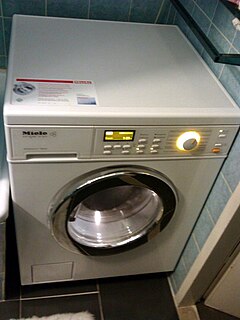
A combo washer dryer is a combination in a single cabinet of a washing machine and a clothes dryer. It should not be confused with a "stackable" combination of a separate washing machine and a separate clothes dryer.
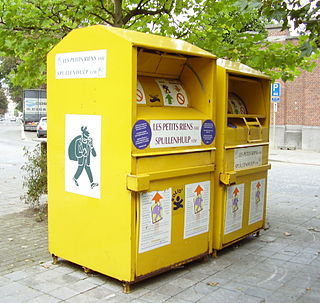
Textile recycling is the method or process of reusing or reprocessing used clothing, fibrous material, and clothing scraps from the manufacturing process. Textiles in municipal solid waste are found mainly in discarded clothing, although other sources include furniture, carpets, tires, footwear, and non-durable goods such as sheets and towels
Decatising or decatizing, also known as crabbing, blowing, and decating, is the process of making permanent a textile finish on a cloth, so that it does not shrink during garment making. The word comes from the French décatir, which means to remove the cati or finish of the wool. Though used mainly for wool, the term is also applied to processes performed on fabrics of other fibers, such as cotton, linen or polyester. Crabbing and blowing are minor variations on the general process for wool, which is to roll the cloth onto a roller and blow steam through it.

The conservation and restoration of textiles refers to the processes by which textiles are cared for and maintained to be preserved from future damage. The field falls under the category of art conservation as well as library preservation, depending on the type of collection. In this case, the concept of textile preservation applies to a wide range of artifacts, including tapestries, carpets, quilts, clothing, flags and curtains, as well as objects which ‘’contain’’ textiles, such as upholstered furniture, dolls, and accessories such as fans, parasols, gloves and hats or bonnets. Many of these artifacts require specialized care, often by a professional conservator. The goal of this article is to provide a general overview of the textile preservation process, and to serve as a jumping-off point for further research into more specialized care. Always contact a professional conservator if you are unsure of how to proceed in the preservation process.

Primarily, nap is the raised (fuzzy) surface on certain kinds of cloth, such as velvet or moleskin. Nap can refer additionally to other surfaces that look like the surface of a napped cloth, such as the surface of a felt or beaver hat.

In textile manufacturing, finishing refers to the processes that convert the woven or knitted cloth into a usable material and more specifically to any process performed after dyeing the yarn or fabric to improve the look, performance, or "hand" (feel) of the finish textile or clothing. The precise meaning depends on context.

Ironing is the use of a machine, usually a heated tool, to remove wrinkles from fabric. The heating is commonly done to a temperature of 180–220 °Celsius, depending on the fabric. Ironing works by loosening the bonds between the long-chain polymer molecules in the fibers of the material. While the molecules are hot, the fibers are straightened by the weight of the iron, and they hold their new shape as they cool. Some fabrics, such as cotton, require the addition of water to loosen the intermolecular bonds. Many modern fabrics are advertised as needing little or no ironing. Permanent press clothing was developed to reduce the ironing necessary by combining wrinkle-resistant polyester with cotton.

Digital textile printing is described as any ink jet based method of printing colorants onto fabric. Most notably, digital textile printing is referred to when identifying either printing smaller designs onto garments and printing larger designs onto large format rolls of textile. The latter is a growing trend in visual communication, where advertisement and corporate branding is printed onto polyester media. Examples are: flags, banners, signs, retail graphics.
Shrinkage(in fabric) is a parameter of testing textile fabrics to measure changes in length and width after washing (laundry), shrinkage failing materials are dimensionally unstable and they can cause de shaping and deforming of the garments or products made out of those materials, it is tested at various stages but important is to before cutting the fabric into further sewn products and after cutting and sewing prior to supplying the products to buyers and end users.It is a necessarily required parameter of quality control to ensure the sizes of the products to avoid any complaints regarding deformation or change in dimensions after domestic laundry. The tests are conducted with provided specifications of buyers imitating the same conditions like washing cycle time, temperature and water ratio and fabric load and sometimes top loading and front loading washing machines are chosen to authenticate the test and assurance of the results. This procedure provides standard and alternate home laundering conditions using an automatic washing machine. While the procedure includes several options, it is not possible to include every existing combination of laundering parameters. The test is applicable to all fabrics and end products suitable for home laundering.
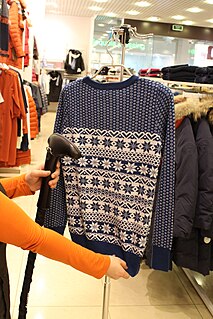
A clothes steamer, also called a garment steamer or simply a steamer, is a device used for quickly removing wrinkles from garments and fabrics with the use of high temperature steam.



















